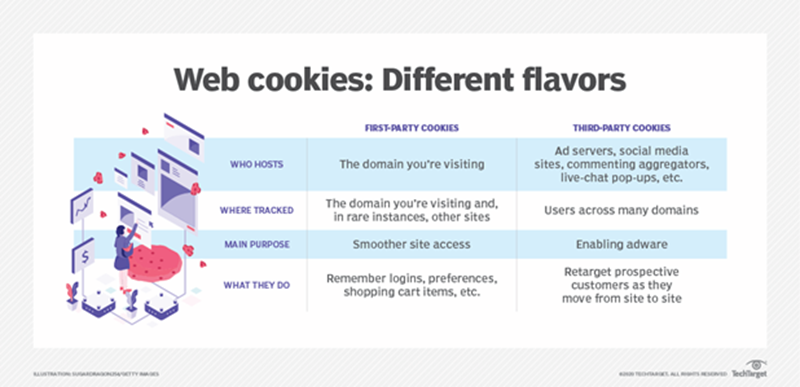
July 6, 2021
Is your FI ready for the loss of the third-party cookie?
With the death of the third-party cookie coming in 2023, it’s causing a lot of upheaval and some slight panic as marketers, and the industry at large, scramble to adjust. For financial institutions, it feels like there's a collective holding of breath and just hoping things can continue as they are. Unfortunately, that's not likely to happen. Most FIs we speak to are incredibly siloed internally, where most departments don’t have access to each other's data or strategy except through formal reports. Worse yet, many institutions don’t have a Marketing Customer Information File (MCIF) or a Customer Relationship Management (CRM).
Did all of this go over your head? You’re not alone – though this is major news, only those heavy in the industry really understand what’s happening and the impact, so let’s break it down and go over some key terms.
Third party cookies are going away as consumer concerns over data privacy have come into the spotlight. Tech giants have shut them down in response – unfortunately, no one in the industry has yet come to a consensus as to what will replace the third-party cookie. So while we wait for Google, Apple and the like to figure it out, there are real steps financial marketers need to take now to revamp their marketing and forge a new path forward.
To jump right into it, yes, you need to be using your customer data for marketing purposes. Yes, there is a way to do this in a compliant and regulatory-friendly manner. Yes, these conversations will be difficult internally.
First-party cookies and collecting data as simple (yet powerful and paramount) as emails is going to be a differentiator. The FIs that can successfully collect and leverage emails will be the ones who will likely see higher conversion rates and better attract Gen Y and Gen Z. Why? Because, though third-party cookies are going away, consumers still expect a very personalized experience online, and this can’t happen without tracking them on some level. Fortunately, there are content management systems (CMS) that have CRMs built into it that enables for website personalization while collecting behavior data that would provide incredible opportunities to cross-sell - all of which is first-party.
Personalizing your website doesn't have to be as intense as the Amazon experience, it could simply be showing mortgage content to users who have previously engaged with the mortgage section of your site. The ability to know and do this is through a CMS/CRM setup. This helps not only the marketing team, but also your lenders, customer service and retail teams.
As a former bank marketer, I’ve seen first-hand the walls that departments can put up, being very protective of their data and their customers. But to thrive and really adopt a digital mindset, all departments – Retail, Business, Marketing, Customer Service, Operations – need to work together. It is imperative for everyone to have access to what your customers or members are up to; that way everyone can see that “hey, we have a bunch of checking customers looking at mortgage... let’s have MLOs reach out or send a timely newsletter with information on the mortgage process” - how would you know that otherwise? That is a major missed opportunity to deepen the relationship, or even lose customers as they find that information elsewhere.
As with all data, as long as your customers opt in to email communication and you’ve provided clear information regarding your use of cookies on the website (with information as to how to opt out), there is nothing against you using it. You likely already have thorough due diligence and vendor management policies and practices in place, so ensure your CRM and CMS (and all technology) is properly vetted and up to date. Once those standards are met, you have the foundation in place to hit the ground running. Then it’s time to build out your customer journey and – dare I say – marketing automation workflows? That’s a topic for another time but can't happen without first-party data.
The pace of change is exceptionally fast, and with this major change, you really can’t wait for the giants to figure it out. It’s time for FIs to catch up and use the data you already have.
Wait – What’s Going On?
Did all of this go over your head? You’re not alone – though this is major news, only those heavy in the industry really understand what’s happening and the impact, so let’s break it down and go over some key terms.
- Cookie
- Sometimes also referred to as a pixel, is a piece of code websites place on visitors’ browsers to learn about their user behavior and collect it for advertising and reporting purposes.
- Third-Party Cookie
- Cookies created by sites other than the one a user is actively on. Most used for remarketing/retargeting and for digital advertising campaigns.
- Examples: Facebook Pixel, ad tags
- Cookies created by sites other than the one a user is actively on. Most used for remarketing/retargeting and for digital advertising campaigns.
- First-Party Cookie
- Cookies that enable you to collect data on your website visitors for your own use. These are going to stay and are the most important to leverage.
- Examples: Google Analytics
- Cookies that enable you to collect data on your website visitors for your own use. These are going to stay and are the most important to leverage.
Third party cookies are going away as consumer concerns over data privacy have come into the spotlight. Tech giants have shut them down in response – unfortunately, no one in the industry has yet come to a consensus as to what will replace the third-party cookie. So while we wait for Google, Apple and the like to figure it out, there are real steps financial marketers need to take now to revamp their marketing and forge a new path forward.
First-Party Cookies and Customer Data
To jump right into it, yes, you need to be using your customer data for marketing purposes. Yes, there is a way to do this in a compliant and regulatory-friendly manner. Yes, these conversations will be difficult internally.First-party cookies and collecting data as simple (yet powerful and paramount) as emails is going to be a differentiator. The FIs that can successfully collect and leverage emails will be the ones who will likely see higher conversion rates and better attract Gen Y and Gen Z. Why? Because, though third-party cookies are going away, consumers still expect a very personalized experience online, and this can’t happen without tracking them on some level. Fortunately, there are content management systems (CMS) that have CRMs built into it that enables for website personalization while collecting behavior data that would provide incredible opportunities to cross-sell - all of which is first-party.
Personalizing your website doesn't have to be as intense as the Amazon experience, it could simply be showing mortgage content to users who have previously engaged with the mortgage section of your site. The ability to know and do this is through a CMS/CRM setup. This helps not only the marketing team, but also your lenders, customer service and retail teams.
End the Silo
As a former bank marketer, I’ve seen first-hand the walls that departments can put up, being very protective of their data and their customers. But to thrive and really adopt a digital mindset, all departments – Retail, Business, Marketing, Customer Service, Operations – need to work together. It is imperative for everyone to have access to what your customers or members are up to; that way everyone can see that “hey, we have a bunch of checking customers looking at mortgage... let’s have MLOs reach out or send a timely newsletter with information on the mortgage process” - how would you know that otherwise? That is a major missed opportunity to deepen the relationship, or even lose customers as they find that information elsewhere.
What About Compliance and Regulations?
As with all data, as long as your customers opt in to email communication and you’ve provided clear information regarding your use of cookies on the website (with information as to how to opt out), there is nothing against you using it. You likely already have thorough due diligence and vendor management policies and practices in place, so ensure your CRM and CMS (and all technology) is properly vetted and up to date. Once those standards are met, you have the foundation in place to hit the ground running. Then it’s time to build out your customer journey and – dare I say – marketing automation workflows? That’s a topic for another time but can't happen without first-party data.The pace of change is exceptionally fast, and with this major change, you really can’t wait for the giants to figure it out. It’s time for FIs to catch up and use the data you already have.







